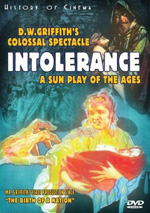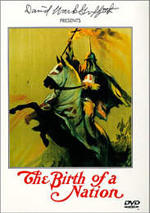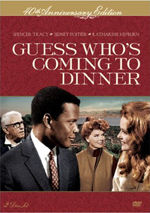|
ALPHA VIDEO
|

| |
|
MOVIE INFO
|
|
Director:
D.W. Griffith
Cast:
Mae Marsh, Robert Harron, F.A. Turner, Sam De Grasse, Vera Lewis
Writing Credits:
D.W. Griffith, Anita Loos, Walt Whitman (poem, "Out of the Cradle Endlessly Rocking")
Tagline:
The Cruel Hand of Intolerance.
Synopsis:
D.W. Griffith’s masterpiece encompasses four stories (the modern era, Jerusalem, 1572 Paris, and Babylon), tackling both time and geography. Boasting a cast of thousands, gargantuan sets, chariot races, the crucifixion, death defying stunts, and the fall of Babylon, Intolerance truly gives meaning to the words, "epic cinema." There can be no complete collection of silent cinema without this celluloid masterpiece.
Box Office:
Budget
$385.907 thousand.
MPAA:
Rated NR
| |
|
DVD DETAILS
|
Presentation:
Fullscreen 1.33:1
Audio:
English PCM Stereo
Subtitles:
None
Closed-captioned
Supplements Subtitles:
None
Runtime:167 min.
Price: $6.98
Release Date: 11/18/2003
Bonus:
• None
| |
|
PURCHASE @ AMAZON.COM
|

| |
|
EQUIPMENT
|
Panasonic 50" TH-50PZ77U 1080p Plasma Monitor; Harman/Kardon DPR 2005 7.1 Channel Receiver; Toshiba A-30 HD-DVD/1080p Upconverting DVD Player using HDMI outputs; Michael Green Revolution Cinema 6i Speakers (all five); Kenwood 1050SW 150-watt Subwoofer.
| |
|
RELATED REVIEWS
|


| |
[an error occurred while processing this directive]
|
Intolerance: A Sun Play Of The Ages (1916)
|
|
Reviewed by Colin Jacobson (March 10, 2008)
When the AFI released their first list of the 100 Greatest American Films a decade ago, DW Griffith made the chart with 1915’s Birth of a Nation. While Griffith still earned one slot on the AFI’s updated 10th anniversary list, the selected film changed. Birth dropped off the chart entirely, and in its place, we found Griffith’s follow-up: 1916’s Intolerance.
This alteration seems ironic given the title of the new selection and the fact that Birth’s disappearance may reflect some intolerance of its own. After all, Birth often acts as a love letter to the Ku Klux Klan, so no matter how innovative and influential it may be as a film, it will always inflame passions against it.
Does this mean that Intolerance shows up on the new AFI list in an attempt to display greater political correctness? Perhaps, or maybe the voters just think it presents a better film. In any case, it stands as the oldest movie on the AFI 100 list, and one of only a few silent offerings.
Subtitled “Love’s Struggles Throughout the Ages”, Intolerance splits into four eras with four different – though related – tales. We get “Modern Day”, “Paris” (1572 AD), “Jerusalem” (circa the time of Christ) and “Babylon” (539 BC). As declared by an early title card, “Each story shows how hatred and intolerance through all the ages have battled against love and charity”.
This means we jump from one tale to another throughout the film. “Modern Day” and “Babylon” easily dominate the proceedings. In “Modern Day”, we see how “reformers” cause havoc in the life of a young couple, while “Babylon” looks on the battles among the powers of that age. “Jerusalem” offers little more than Jesus’s Greatest Hits, really; it’s the least prominent of the four. “Paris” looks at the excesses of that era’s ruling class and the problems they cause. It gets a lot more play than “Jerusalem” but not nearly as much as the others.
It’s easy to see Intolerance as something of an apology for the racist excesses of Birth. The theme that links all four stories comes from the film’s disdain for those who deem themselves superior to others and judge the actions and attitudes of others. The flick also depicts all the problems that stem from negative trends like envy, lust and – you guessed it – intolerance. Was this Griffith’s attempt to tell his critics to back off? The film sure comes across that way, as never have I seen an epic so devoted to emotion over story.
In terms of narrative, “Modern Day” easily offers the most coherent tale. Really, it’s the only one that makes real sense, as we can easily follow its plot and characters. Actually, “Jerusalem” is simple to handle as well, but it’s such a minor part of Intolerance that it almost doesn’t count. Both “Babylon” and “Paris” can become rather convoluted.
On the other hand, those two provide the movie’s most epic scenes. “Babylon” proves particularly extravagant. With its enormous, lavish sets and scores of extras, that part of Intolerance offers grand filmmaking on a shockingly epic scale. I expect this kind of grandness from something made 40 years later; to see it in a flick from the early days of cinema truly surprises me. I wish the “Babylon” story made more sense, but the production values are incredible.
As is the full scope of Intolerance. Again, it’s easy to forget just how new movies were back in 1916. The form remained pretty primitive and basic, but Griffith made a true epic in which he deftly interwove four different stories. No, I can’t say that all of them succeed, but the ambition on screen here dazzles. A flick like this would still be daring today, but in such an old picture, the scale really knocks me for a loop. I can’t say it’s the most entertaining movie I’ve seen, but as a piece of cinema history, Intolerance is a fascinating document.
|
The DVD Grades: Picture D-/ Audio D-/ Bonus F
|
|
Intolerance appears in an aspect ratio of 1.33:1 on this single-sided, double-layered DVD; due to those dimensions, the image has not been enhanced for 16X9 televisions. I hate to be really critical of a transfer for such an ancient flick, but the visuals of Intolerance were too problematic for me to view it in a positive manner.
Every aspect of the image demonstrated problems. Unsurprisingly, source flaws caused the greatest concerns. These cropped up constantly through the film and often became major. I saw tears, scratches, blotches, thin lines, debris, specks, and even some big mysterious “X”s during the crucifixion scene. Those looked like someone wrote on the print with a grease pencil; they were so prominent and strange that I almost wondered if they were part of the original film! The transfer suffered from a heavy degree of print defects, and I also saw a band of what appeared to be video distortion at the bottom of the screen. Did the DVD come from an old videotape? It wouldn’t surprise me.
Sharpness fared better but still had its issues. Most of the flick seemed pretty soft, as I never saw any shots that looked truly concise and well-delineated. I didn’t think the lack of clarity was an overwhelming concern, though that may have been because I was so distracted by all the source flaws. Suffice it to say that this was a consistently fuzzy image without definition.
Ala Birth of a Nation, Intolerance often used tints for its various scenes. These usually stayed with pretty neutral colors but occasionally went for reds, purples or greens. I thought this was a pointless stylistic choice, to be honest, as it never added to the film. The colors also failed to look good. They were heavy and blotchy most of the time, and they made things more difficult to see. The movie suffered from a generally flat quality and was fairly murky on most occasions.
All in all, Intolerance offered an ugly transfer. I almost never give “F” grades for picture, but I was tempted here. I didn’t do that simply because of the movie’s age; I have to be a little more forgiving for something made 92 years ago. Nonetheless, I really believe that the image could be improved with some effort; this can’t be the best it can offer.
As for the PCM stereo soundtrack of Intolerance, it clearly came from a series of vinyl records – and not very well-preserved records much of the time. The quality of the audio varied quite a lot throughout the presentation. At times, the elements sounded reasonably lively and dynamic, but plenty of worse sounding sequences occurred. Many parts of the track seemed flat and muddy. Lots of source flaws didn’t help. I noticed quite a bit of static, clicks and distortion throughout some parts of the track. At its best, the material seemed satisfactory, but it rarely reached that level. Indeed, the shift from bad to good to bad became awfully jarring.
The stereo imaging was also erratic. Some sequences boasted minor spread to the sides, but most sounded like broad monaural. There was virtually no clear delineation of elements, as they remained center-bound, really. This was a consistently unsatisfying soundtrack due to the poor quality of the source materials.
In terms of extras, this disc includes absolutely nothing. That’s too bad, as I’d like to hear a historical perspective on the film. I’m sure there’s lots to say about it, but we don’t learn anything here.
As a movie, Intolerance provides an absorbing piece of history. It doesn’t always succeed as storytelling, but it’s so grand and intricate that it keeps us interested. As a DVD, unfortunately, Intolerance has problems. Both picture and sound are terrible, and it includes no extras. I recommend this as a film but can’t advocate the pursuit of this poor release.
|
|
[an error occurred while processing this directive]
|
|

